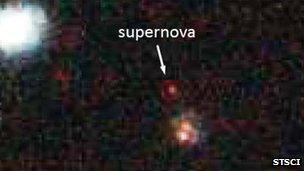Supernova 'Mingus' could shed light on dark energy
- Published

Supernovas are traditionally named after composers
Astronomers have spotted the most distant supernova ever seen.
Nicknamed "Mingus", it was described at the 221st American Astronomical Society meeting, external in the US.
These lightshows of dying stars have been seen since ancient times, but modern astronomers use details of their light to probe the Universe's secrets.
Ten billion light-years distant, Mingus will help shed light on so-called dark energy, the force that appears to be speeding up cosmic expansion.
Formally called SN SCP-0401, the supernova was something of a chance find in a survey carried out in part by the Supernova Cosmology Project (SCP) using the Hubble space telescope, first undertaken in 2004.
But the data were simply not good enough to pin down what was seen. As David Rubin of the University of California, Berkeley, lead author on the study, told the AAS meeting, "for a sense of brightness, this supernova is about as bright as a firefly viewed from 3,000 miles away".
Further news had to wait until astronauts installed the Wide Field Camera 3 on the Hubble telescope in 2009 and again trained it on the candidate, which had - in an SCP tradition of naming supernovae after composers - already been named after jazz musician Charles Mingus.
"Unfortunately, it took the development of Wide Field Camera 3 to bring home what the [2004] measurements meant," Mr Rubin told BBC News.
"The sensitivity is a few times better, which makes a huge difference, and we have a much cleaner image."

The Wide Field Camera 3 enabled scientists to focus in on Mingus
The team went on to confirm that the supernova was in fact a Type 1a - a particular class of exploded star whose light occurs in such a regular way that it is known as a "standard candle".
'Bit of history'
What interests astronomers trying to find ever more distant Type 1a supernovae - distant both in space and in time - is the chance to compare them to better-known, more local supernovae.
"We were able to watch these changes in brightness and spectral features for an event that lasted just a few weeks almost 10 billion years ago," said Saul Perlmutter, who leads the Supernova Cosmology Project.
Prof Perlmutter shared the 2011 Nobel prize in physics, external for work with Type 1a supernovae that proved our Universe is speeding up in its expansion.
Elucidating the mysterious force, "dark energy", which has been invoked as the cause of the expansion, will require careful study of supernovae all the way back to the epoch of the earliest stars.
"We're seeing two-thirds of the way back to the beginning of the Universe, and we're getting a little bit of history where the physics of what makes a supernova explode have to all work out the same way there as they do near here," he told the meeting.
The group's study is published online, external and will appear in the Astrophysical Journal on 20 January.
Dark ambitions

Supernova SN SCP-0401 fits into a wider story, Prof Frieman says
The meeting also heard from Joshua Frieman, director of the Dark Energy Survey - a five-year mission using the most powerful camera ever trained on the skies to get to the bottom of the dark matter mystery.
The phone-booth-sized Dark Energy Camera snapped its first images in September 2012, external and will begin its formal mission in September this year, looking not only at supernovae but also at three other dark-energy signatures in the cosmos.
Prof Frieman told BBC News that the distant supernova result fits neatly into a story that he hoped the Dark Energy Survey would explore in great detail.
"What they're doing is using the Hubble telescope to go really deep - we're going to use the Dark Energy Survey to go very broad," he explained to BBC News.
"They're finding tens of supernovae at these high [distances], and we're going to find thousands of supernovae not quite as deep. You really need both of those together to really make progress in trying to figure out why the Universe is speeding up."
- Published18 September 2012
- Published19 September 2012
- Published8 September 2011